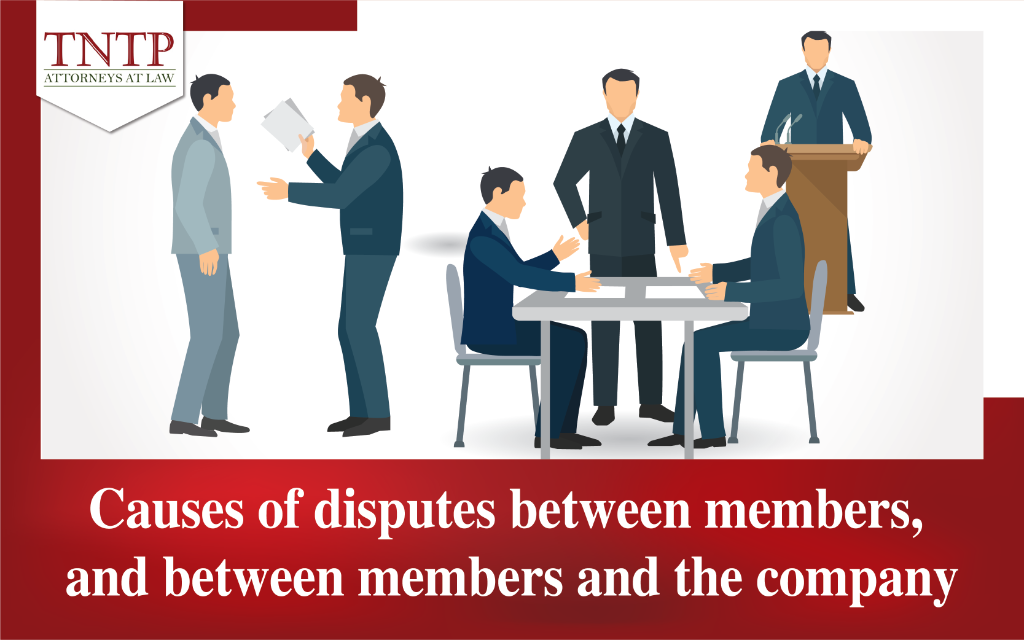Causes of disputes between members, and between members and the company

Disputes between members, and between members and the company, are increasingly numerous and complex. So, what are the causes of the aforementioned disputes? Based on current legal regulations and practical basis, it can be seen that the causes of disputes between company members, and between members and the company, often stem from the following reasons:
1. Not recognizing the importance of legal factors when starting a business
Legal factors directly affect the formation and development of the company. However, some legal issues that need attention when starting a business have not been considered by the company founders, such as:
● Not correctly understanding the moment of the company’s establishment and legal recognition, leading to confusion about the moment of establishing company membership status. According to legal regulations, a company is only allowed to conduct business activities, have a legal personality, and become an independent subject in legal relations from the moment the company is granted the Business Registration Certificate by the competent state authority. Before this moment, entities might have carried out procedures such as capital contribution, renting factories, warehouses, business locations, etc., however, these actions do not mean they have become company members or have the right to do business.
● Not paying attention to issuing internal legal documents, especially the company charter. The company charter is the most important legal document in a company, detailing the company’s organizational structure – management, charter capital, membership status, and other issues related to company operations. However, company founders often think that the company charter is just an administrative procedure required to establish a company. Therefore, they often use available templates on the internet, change company information, and then submit it to the competent state authority to legalize the business registration application without realizing that the contents of the Charter will later affect their rights and obligations towards the company.
2. Not focusing on issues of management, control, and internal organization
The business model in Vietnam is mainly small and medium-sized enterprises with not many members, so it is easy to manage when newly established. However, over time, the business will grow and “recruit” more new members, leading to changes in the ownership ratio of shares/capital contributions, profit/dividend distribution, issues of personnel management, business operation, etc. The larger the company, the more complicated the management, control, and internal organization. If not timely adapted with appropriate solutions, the business will not be able to manage and control the issues arising in the company in time. Then, it is inevitable that disputes between company members, and between members and the company will occur.
3. Not clearly defining the ratio of capital contributions, and share ownership in the company at the time of establishment
According to the Law on Enterprises 2020, charter capital is the total value of assets contributed or committed to contribute by the company members, the company owner when establishing a limited liability company, a partnership company; is the total face value of shares sold or registered to buy when establishing a joint-stock company. The ownership ratio of shares/capital contributions is the basis to determine the extent of rights and the fulfilment of obligations of members, and shareholders towards the company, for example, voting rights, rights to profit/dividend distribution, rights to share the company’s assets upon dissolution, and bankruptcy.
Also, according to the Law on Enterprises 2020, within 90 days from the date the company is granted the Business Registration Certificate, company members/shareholders must contribute the correct and full type of assets they have committed to contribute. However, in practice, the following cases often occur:
● Members do not make capital contributions on time and with the correct type of assets committed to contribute;
● Capital contribution is only made on “paper” and not implemented;
● Capital contribution is not carried out according to the correct procedures, such as no asset handover minutes, not carrying out procedures for transferring ownership or the right to use assets;
● Company members/shareholders use assets that they do not legally own or have the right to use for capital contribution, etc.
If the above cases occur, the company member status may no longer exist, the company’s charter capital is changed, and the ownership ratio of shares/capital contributions is changed, consequently, the rights and obligations of members/shareholders towards the company will also change. However, many businesses and company founders do not fully recognize the importance of establishing member/shareholder status and determining the ownership ratio of shares/capital contributions, thereby neglecting or intentionally violating without foreseeing the consequences leading to disputes.
4. Stemming from the personal interests of members within the company
Sometimes disputes between company members, and between members and the company, stem from the personal interests of these members themselves. Typically, if shareholders believe their interests are infringed, the information about the company’s operations is not provided fully, inaccurately, etc., disputes often arise between members and the company. Especially, in cases where major shareholders, those holding positions such as Legal Representatives or chairman of the Board of Directors do not ensure the interests of “weaker” shareholders, disputes often arise between members as well as between members and the company.
Above is the content of the article “Causes of disputes between members, and between members and the company” that TNTP presents to the readers. We hope the shared information is useful to those interested in this issue.
Sincerely,


